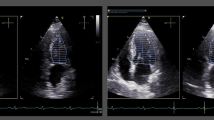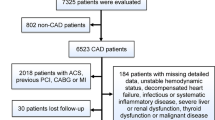Abstract
High-sensitivity C-reactive protein predicts future cardiovascular events in both healthy individuals and patients with unstable and stable coronary syndromes. Few data are available about the incidence and the relation to inflammation of troponin elevation following percutaneous coronary intervention (PCI), a potential predictor of longterm outcome. We sought to confirm the impact of embolization on long-term outcome and evaluate the ability of baseline inflammation to predict troponin elevation induced by PCI. We prospectively analyzed 200 patients treated by PCI for stable or Braunwald IIA class unstable angina. The patients were recruited between January 1997 and May 1999, and the population was followed during a mean follow-up of 32 months. Major adverse cardiac events (MACEs) were defined as the occurrence of death, myocardial infarction or recurrent angina requiring repeat PCI, or coronary artery bypass grafting. During the follow-up period, 58 MACEs were observed. By multivariate analysis, independent predictors for the occurrence of MACEs were unstable angina and troponin I level after PCI (P < 0.0001 for both). No correlation was found between baseline inflammation and significant troponin I elevation post PCI and by multivariate analysis, no biological variable was a predictor of troponin I elevation post PCI. Baseline inflammation cannot predict onset of minor myonecrosis damage (expressed by troponin elevation) induced by PCI, a significant predictor of long-term outcome in this setting.
Similar content being viewed by others
References
Chen MC, Chen CJ, Yang CH, Wu CJ, Fang CY, Hsieh YK, Chang HW (2007) Interleukin-18: a strong predictor of the extent of coronary artery disease in patients with unstable angina. Heart Vessels 22:371–375
Ridker PM, Rifai N, Rose L, Buring JE, Cook NR (2002) Comparison of C-reactive protein and low-density lipoprotein cholesterol levels in the prediction of first cardiovascular events. N Engl J Med 347(20):1557–1565
Ridker PM, Hennekens CH, Buring JE, Rifai N (2000) C-reactive protein and other markers of inflammation in the prediction of cardiovascular disease in women. N Engl J Med 342:836–843
Liuzzo G, Biasucci LM, Gallimore JR, Grillo RL, Rebuzzi AG, Pepys MB, Maseri A (1994) The prognostic value of C-reactive protein and serum amyloid a protein in severe unstable angina. N Engl J Med 331:417–424
Zebrack JS, Muhlestein JB, Horne BD, Anderson JL (2002) Creactive protein and angiographic coronary artery disease: independent and additive predictors of risk in subjects with angina. J Am Coll Cardiol 39:632–637
Buffon A, Liuzzo G. Biasucci LM, Pasqueletti P, Ramazzotti V, Rebuzzi AG, Crea F, Maseri A (1999) Preprocedural serum levels of C-reactive protein predict early complications and late restenosis after coronary angioplasty. J Am Coll Cardiol 34:1512–1521
Gaspardone A, Crea F, Versaci F, Tomai F, Pellegrino A, Chiarello L, Gioffre PA (1998) Predictive value of C-reactive protein after successful coronary-artery stenting in patients with stable angina. Am J Cardiol 82:515–518
Gaspardone A, Ciavolella M, Carlizzi G, Xagoraris V, Romeo F, Gioffré PA (1982) Determinazione della proteina C-reattiva in cardiochirurgia: importanza nel monitoraggio post-operatorio delle complicanze. Cardiologia 27:1121–1132
Gach O, Legrand V, Biessaux Y, Chapelle JP, Vanbelle S, Pierard LA (2007) Long-term prognostic significance of high-sensitivity C-reactive protein before and after coronary angioplasty in patients with stable angina pectoris. Am J Cardiol 99:31–35
Herrmann J, Von Birgelen C, Haude M, Volbracht L, Malyar N, Eggebrecht H, Konorza TF, Baumgart D, Erbel R (2002) Prognostic implication of cardiac troponin T increase following stent implantation. Heart 87:549–553
Nallamothu BK, Chetcuti S, Mukherjee D, Grossman PM, Kline-Rogers E, Werns SW, Bates ER, Moscucci M (2003) Prognostic implication of troponin I elevation after percutaneous coronary intervention. Am J Cardiol 91:1272–1274
Cavallinin C, Savonitto S, Violini R, Arraiz G, Plebani M, Olivari Z, Rubartelli P, Battaglia S, Niccoli L, Steffenino, Ardissino D (2005) Impact of the elevation of biochemical markers of myocardial damage on long-term mortality after percutaneous coronary intervention: results of the CK-MB and PCI study. Eur Heart J 26:1494–1498
Bhatt DL, Topol EJ. Does creatinine kinase-MB elevation after percutaneous coronary intervention predict outcomes in 2005? (2005) Circulation 112:906–915
Abdelmeguid AE, Topol EJ, Whitlow PL, Sapp SK, Ellis SG (1996) Significance of mild transient release of creatine kinase-MB fraction after percutaneous coronary interventions. Circulation 94:1528–1536
Prasad A, Singh M, Lerman A, Lennon RJ, Holmes DR, Rihal CS (2006) Isolated elevation in cardiac troponin T after percutaneous coronary intervention is associated with higher long-term mortality. J Am Coll Cardiol 48:1765–1770
Heeschen C, Vanden Brand M, Hamm CW, Simoons ML (1999) Angiographic findings in patients with refractory unstable angina according to troponin T status. Circulation 104:1509–1514
Bhatt DL, Topol EJ (2002) Need to test the arterial inflammation hypothesis. Circulation 106:136–140
Chew DP, Bhatt DL, Robbins MA, Penn MS, Schneider JP, Lauer MS, Topol EJ, Ellis SG (2001) Incremental prognostic value of elevated baseline C-reactive protein among established markers of risk in percutaneous coronary intervention. Circulation 104: 992–997
Saadeddin SH, Habbab MA, Sobki SH, Ferns GA (2002) Association of systemic inflammatory state with troponin I elevation after elective uncomplicated percutaneous coronary intervention. Am J Cardiol 89:981–983
Pasceri V, Patti G, Nusca A, Pristipino C, Richichi G, Di Sciascio G (2004) Randomized trial of atorvastatin for reduction of myocardial damage during coronary intervention: results from the ARMYDA (Atorvastatin for Reduction of MYocardial Damage during Angioplasty) study. Circulation 110:674–678
Sharma SK, Kini A, Marmur JD, Fuster V (2000) Cardioprotective effect of prior beta-blocker therapy in reducing creatine kinase-MB elevation after coronary intervention: benefit is extended to improvement in intermediate-term survival. Circulation 102:166–172
Tardiff BE, Califf RM, Tcheng JE, Lincoff AM, Sigmon KN, Harrington RA, Mahaffey KW, Ohman EM, Teirstein PS, Blankenship JC, Kitt MM, Topol EJ (1999) Clinical outcomes after detection of elevated cardiac enzymes in patients undergoing percutaneous intervention. IMPACT-II Investigators. Integrilin (eptifibatide) to Minimize Platelet Aggregation and Coronary Thrombosis-II. J Am Coll Cardiol 33:88–96
Oka H, Ikeda S, Koga S, Miyahara Y, Kohno S (2008) Atorvastatin induces associated reductions in platelet P-selectin, oxidized low-density lipoprotein, and interleukin-6 in patients with coronary artery diseases. Heart Vessels 23:249–256
Iakovou I, Mintz GS, Dangas G, Abizaid A, Mehran R, Kobayashi Y, Lansky AJ, Aymong ED, Nikolsky E, Stone GW, Moses JW, Leon MB. (2003) Increased CK-MB release is a “trade-off” for optimal stent implantation: an intravascular ultrasound study. J Am Coll Cardiol 42:1900–1905
Author information
Authors and Affiliations
Corresponding author
Rights and permissions
About this article
Cite this article
Gach, O., Louis, O., Chapelle, J.P. et al. Baseline inflammation is not predictive of periprocedural troponin elevation after elective percutaneous coronary intervention. Heart Vessels 24, 267–270 (2009). https://doi.org/10.1007/s00380-008-1120-3
Received:
Accepted:
Published:
Issue Date:
DOI: https://doi.org/10.1007/s00380-008-1120-3




